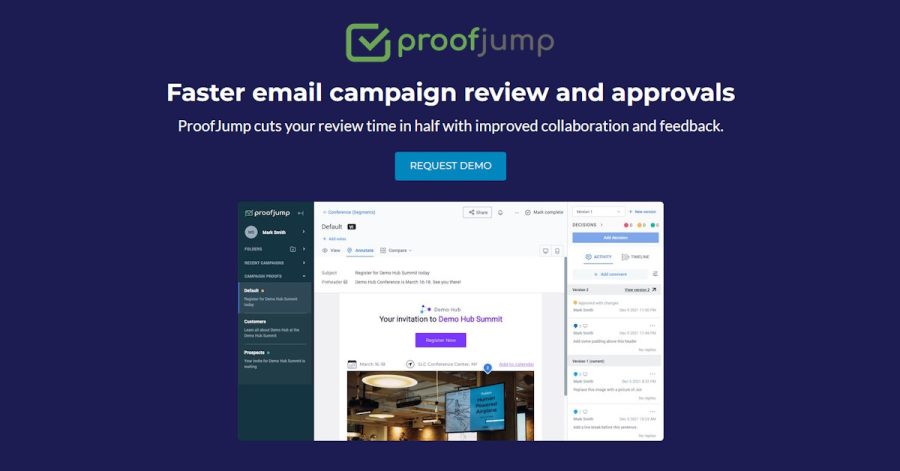
How ProofJump Streamlines Your Email Approval Process
Did you know the top two reasons deadlines are missed are approval delays and communication issues between stakeholders? Research also shows that marketers spend an average of 3.9 hours in the review and approval process for every email message they send.
Sound familiar? Fortunately, there is a solution.
With ProofJump, you and your stakeholders can use a solution built specifically for email campaign review and approvals to save time, money, and frustration – all while ensuring your campaigns go out on time and error-free.
The result? Goals are hit and everyone is happy!
What is ProofJump?
ProofJump is a web-based application built for email marketing campaign managers who need a single place for all internal and external stakeholders to proofread, collaborate, and approve email marketing campaigns.
Unlike tools that simply show you how an email campaign will render when recipients open it using different mailbox providers, ProofJump includes all of the features and functionality that email marketers need to QA campaigns, including:
- Create and manage simple to highly-complex campaign proofs and versions (including images, text, links, and dynamic content)
- Manage the entire review process from end-to-end
- Collaborate and communicate with all stakeholders (including coworkers, clients, agencies, and guests) in real-time and in a single centralized place
Not only does ProofJump fit into your email approval process seamlessly – ProofJump enhances and improves your review process while solving many of the common problems email marketers face, such as:
- Ensuring everyone is reviewing the correct version of a campaign
- Eliminating costly double-work
- Maintaining a clear record of comments, discussions, and edits
- Tracking decision-making
- Holding stakeholders accountable for meeting deadlines
How Email Marketing Campaign Managers Use ProofJump to Manage the Email Review Process
It takes just minutes to log into your ProofJump account and create a new email campaign with corresponding proofs. The software allows you to group multiple proofs together within a “campaign” which significantly streamlines collaboration. All variants and versions along with all edits, comments, and decisions are recorded and stored in one place in real-time, so everyone is always on the same page.
Create Your Email Campaign and Proofs
The Campaign Overview page within the ProofJump application is where you can create a campaign, delete a campaign, and manage campaigns.

Click on any campaign from the Campaigns Overview page to add and manage proofs. Keep in mind, “proofs” could refer to image or visual proofs of initial designs, HTML proofs, or pre-prepared email proofs (image or HTML).

Adding proofs to a campaign from your email marketing platform (e.g., MailChimp, Salesforce Marketing, etc.) couldn’t be easier! Just email a test message of your campaign to your ProofJump campaign-specific email address, and you’re done! The proofs will be added to your campaign in ProofJump for stakeholders to review.
You can also upload proof files from your desktop, paste HTML of your proof into ProofJump, or capture a URL of a web page that provides the HTML of your proof to add it to a campaign.
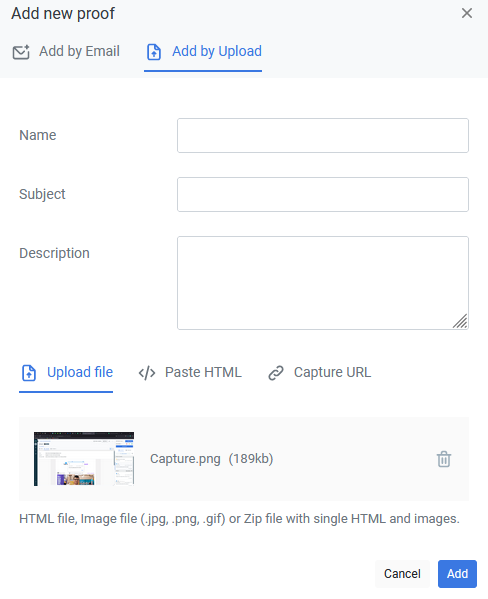
Manage Your Email Campaign
When the campaign manager opens a campaign in ProofJump, you can set and change the Campaign Stage as needed to keep the review process on track. Seven status options are available, but you can edit them to match your own process stages:
- None
- Not Started
- On Hold
- In Progress
- Waiting for Approval
- Ready to Send
- Complete
You can also track approvals at a glance from the list view of each campaign within ProofJump.

The campaign owner can add or delete proofs in a campaign at any time. To compare proofs side-by-side, just select them. To identify different versions of a campaign, select one proof as the Master and upload the variants. And when all approvals have been obtained, mark the proof as Complete to show stakeholders the review cycle for that proof is finished.
Comments and the history of a campaign/proof review are displayed in the right-hand pane of the ProofJump app. You can filter down to the individual proof level to review historical comments and comment activity.
Manage Your Proofs
The proofs page within ProofJump is where you can view a proof that you’ve created as the owner or that you’ve been invited to review. When you click “View Proof” from the campaign page, the proof page opens for the selected proof.
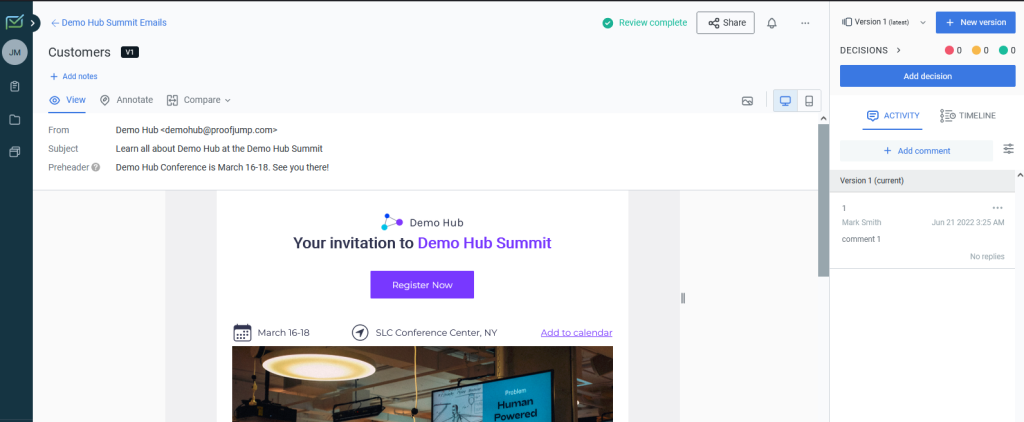
The proof page provides a lot of information and features for the campaign manager and stakeholders, including:
- Proof Version: Stakeholders can only make comments on the most recent version of a proof. For proofs using automatic dynamic content labels (an advanced feature), the variant of the proof is also displayed. The “Master” label will appear if the proof is the master version.
- Email Header: Stakeholders can preview how recipients will see the sender, subject line, and preheader when they receive the message.
- View: Stakeholders can view the proof from the recipient’s perspective and confirm that links work.
- Annotate: Reviewers can use a pin-drop to add comments directly to proofs.
- Compare: Reviewers can compare different versions of the same proof or different proofs (and comment streams) side-by-side.
- Notes: This is a text box to record information and communicate with the team.
- Notifications: Stakeholders can control when they’ll receive notifications related to changes to the proof. It’s recommended that all stakeholders enable notifications.
- Share: The share button allows you to manage reviewers, copy the campaign link, send proofs by email, and send notifications to reviewers.
- Mark Complete: The proof owner can click this button on the proof page to formally finalize the review.
- View Control: Toggle images on or off, view as a desktop user, or view as a mobile user in responsive mode.
- Right-hand Pane: Review the updated stream of comments, annotations, and updates on the proof.
- Version: Review old proof versions or add new versions.
- Decisions: View current or previous decisions, or add a new decision.
- Tasks: Mark tasks that were created through annotations as complete.
How Reviewing Stakeholders Use ProofJump to Proofread and Approve Email Campaign Proofs
When it’s time for stakeholders to review campaign proofs that you own, you simply share the entire campaign or individual proof links with them. Stakeholders receive an email with the campaign or proof link that they can click to go directly to the campaign page where they can view all proofs in the campaign (or an individual proof). As the campaign or proof owner, you can delete reviewers at any time.
If the stakeholder’s link leads to a campaign page, they’ll be able to review all proofs within the campaign. The image below shows what the campaign page looks like for an unregistered guest reviewer:
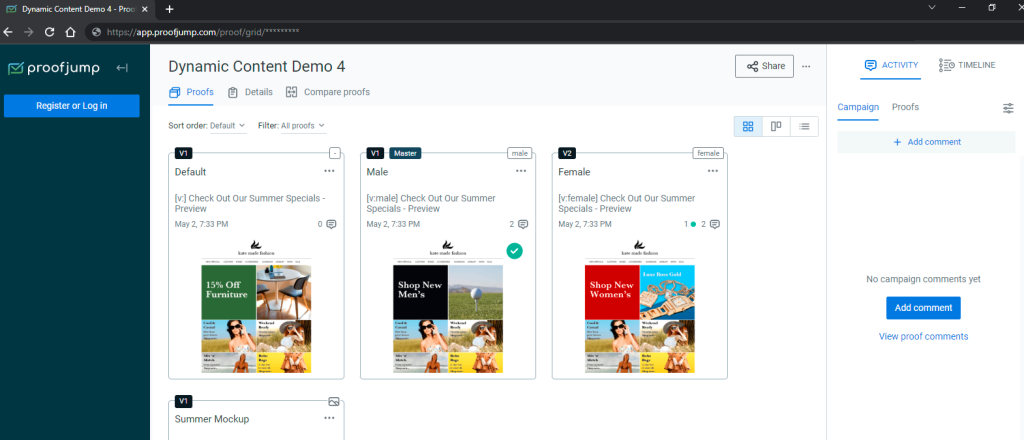
Proofing Options
To review proofs, each stakeholder will need to click on the proof in the campaign page (or navigate directly to the proof page if that’s the link they received). When stakeholders open a proof to review it, they’ll find many options on the proof page, including:
- Type of Proof: Stakeholders can review image proofs or email proofs. Image proofs allow reviewers to provide feedback on an image. Note that an image proof is not a responsive email campaign that corresponds to a web page. Email proofs are proofs of email content that are functional. Stakeholders can review responsive and image-blocked views, links, source code, and more.
- Summary: The proof summary displayed above the proof includes the sender address (if the proof was sent as an email), subject line for the specific proof version, and preheader text.
- Metadata: This includes the proof version, and a timeline of events for the proof.
Proofing Views
Stakeholders can review different views of the proof from the proof page to understand how recipients will see the message. For example, they can use the default live view to test links in the email, or they can switch between versions as they wish.
ProofJump offers three additional views that significantly streamline the review process:
1. Image Blocked Mode
Some email providers and some email users block images in messages, so it’s important for reviewers to see what messages will look like when images don’t load for recipients. It’s also important to review the Alt-Text used for each image.

2. Desktop and Mobile Views
Email messages look different depending on whether a recipient opens them on a desktop or mobile device. This feature allows stakeholders to see how your message renders across devices and test responsive break points.

3. Comparison View
The comparison view makes it easy to review different versions of a proof or mobile vs. desktop views side-by-side.
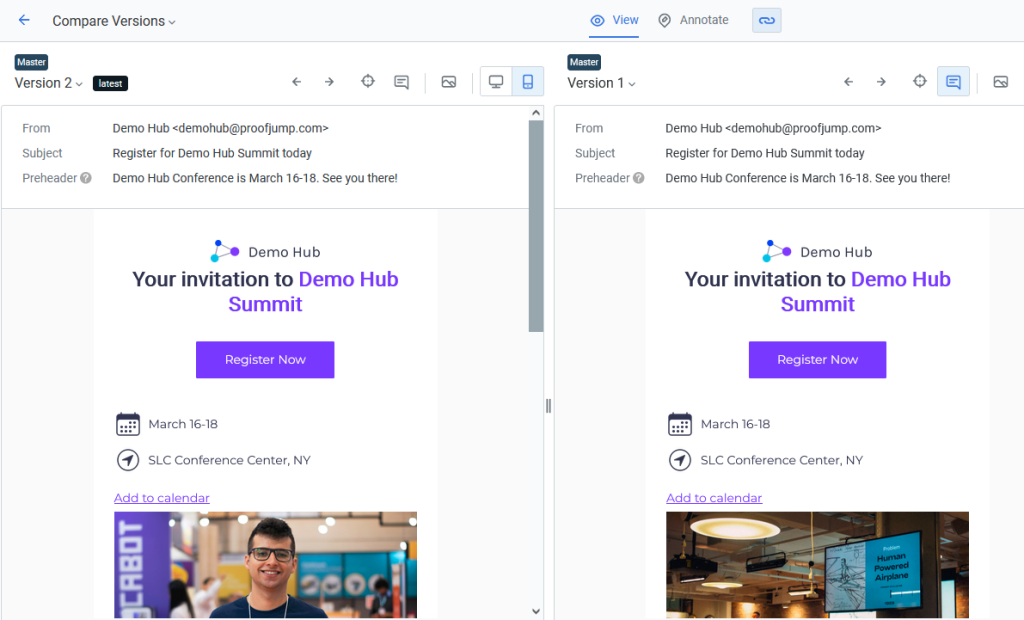
How Stakeholders Communicate and Collaborate Using ProofJump
The biggest breakdown in your review and approval process likely happens due to a lack of transparent communications and easy collaboration.
Bottom-line, if your stakeholders are working in silos, if they’re reviewing email campaigns in their own email inboxes, and if you’re going crazy trying to compile edits and hit deadlines, then you have a communication and collaboration problem.
ProofJump streamlines all communications by giving stakeholders a centralized place for real-time, collaborative review, discussion, and decision-making.
Comments and Annotations
Stakeholders can ask questions, provide input, and communicate with you and each other using the annotation feature in ProofJump. By clicking on the Annotation icon when reviewing a proof, reviewers can place a pin wherever they want to add a comment – directly on the proof. Next, they type their comments in the annotation text box that opens, and click the Submit button.
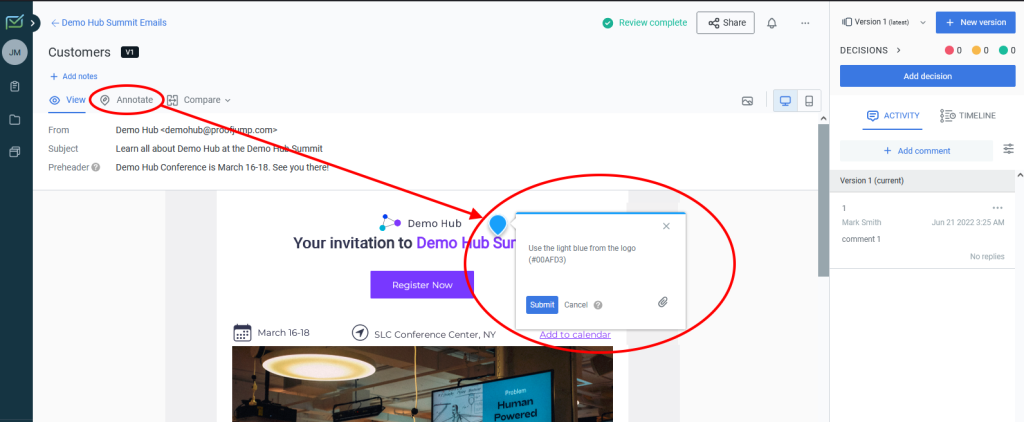
Once submitted, you and all other stakeholders can see the annotation. It also appears in the proof’s comment stream. Annotations update in real-time. If another stakeholder is actively viewing the proof when an annotation is submitted, that annotation is immediately visible to them.
Importantly, all stakeholders who have their notification settings configured to receive updates will receive an email notification about the new annotation, so they can reply immediately. This keeps the review process flowing smoothly and without delays.
Stakeholders who want to respond to an annotation can do so by using the “Reply” option. The reply is immediately visible to you and all stakeholders in the comment stream for the proof.
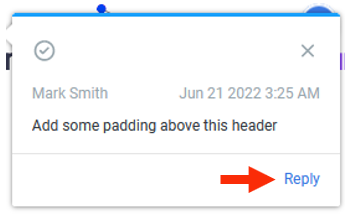
Annotations can also include attachments to support or clarify a comment.
To keep things organized, the campaign owner can mark comments and annotations as “done” by clicking on the checkmark at the bottom left of the comments. There’s no need for anyone to go back and address comments that have already been completed!
Proof Decisions
Reviewers can let other stakeholders know they’re done with their review of a specific proof version using the decision feature in ProofJump. When a reviewer enters a decision, email notifications are sent to all other stakeholders (based on their notification settings).
Decisions are tied to a version of a proof, so if you upload a new version, the new version will have its own decision status. There are three decision states:
- Red – Changes Required: Substantial edits are required. A new version that incorporates the requested changes is needed for another review.
- Yellow – Approved with Changes: Edits are required, but once the edits are made, a new version does not need to be reviewed.
- Green – Approved: The proof is approved by the reviewer as is and no changes are needed.
Stakeholders can add a decision on a proof version from the right-hand pane of the proof page. Once the decision is submitted, it will appear with the proof thumbnail on the campaign page and above the comment stream in the proof page.
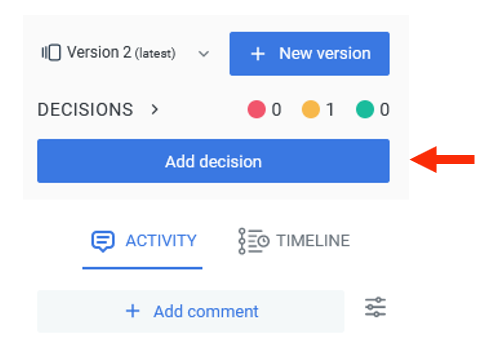
The proof decisions feature makes it extremely easy for everyone to see exactly what the status of a proof version is at any given moment. In other words, it’s easy to spot delays and why those delays are happening!
Inviting Reviewers and Assigning Permissions for Seamless Proofing
To invite someone to use ProofJump for email campaign review, all you need is their email address.
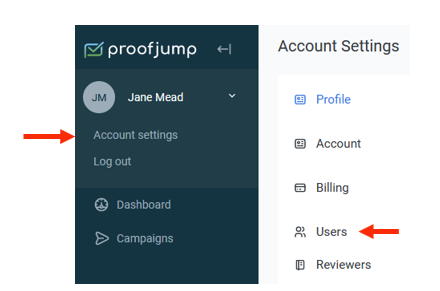
You’ll need to assign a role to each new user. There are multiple user roles in ProofJump with different permissions:
- Reviewer: A reviewer is a registered guest who can view and review proofs that they’re invited to.
- User: A user can create, manage, view, and review proofs when they’re invited by an admin. They can also browse campaign folders and create new campaigns and folders.
- Admin: An admin is a super user who can create, manage and review all proofs as well as browse campaign folders and create new folders. They can also create and manage users.
- Unregistered Guest: An unregistered guest does not have a user account in ProofJump and can only be invited to review a proof on ProofJump via email invitation or a shared link. Their access only allows them to view proofs within the campaign they’re invited to review. When they click the invite link, they’ll have to register as a guest with their name and email address so their annotations and comments are identifiable. They can also choose their notification preferences when they register.
Inviting Users to Set Up Their Own Accounts
You can add a new user by inviting them to set up their own account. As the image below shows, you just need to provide their email address and select their user role.

Inviting Users by Setting up Accounts for Them
ProofJump also gives you the option to set up each user’s account for them rather than asking them to create their accounts. In this case, you need their email address, first name, and last name. You’ll select their role and assign a password to them as shown below.
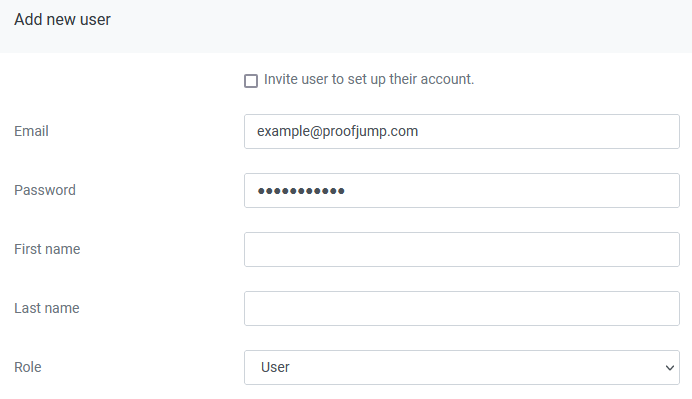
Keep in mind, if you set up a user’s account, you’ll need to let them know what their password is so they can log in.
Configuring Email Notifications
Email notifications alert stakeholders when an update, comment, decision, or any other review action has happened on a proof. Owners of campaigns and proofs can configure the notification settings for each stakeholder when inviting them to review as shown in the image below.
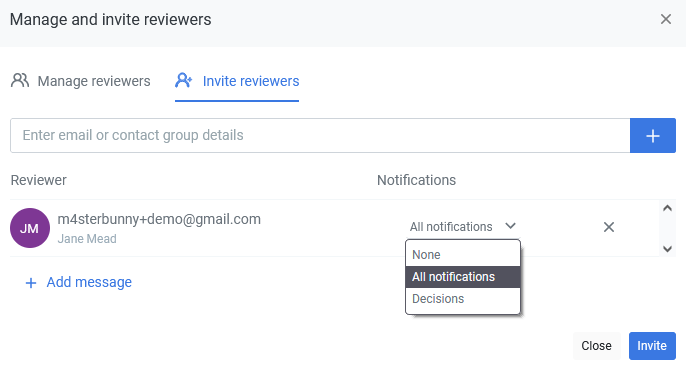
However, reviewers can update their notification settings from the campaign page or the individual proof page. Stakeholders can choose to receive no notifications, notifications related to decisions only (e.g., a decision is made, a new proof is uploaded, a new version is uploaded), or all notifications (e.g., all notifications related to decisions plus new annotations added and new comments added).
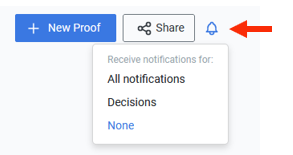
To keep the review process moving with minimal delays, it’s highly recommended that every reviewer configures this setting to receive all notifications.
How to Use ProofJump to Review Dynamic Content and Automate Proof Labels (APL)
ProofJump makes it easy for stakeholders to review and approve multiple variants of email campaigns that use dynamic content and APL on a single page.
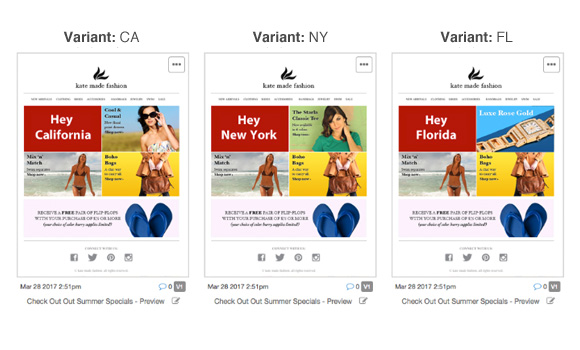
The process is simple. You’ll send one campaign link to stakeholders to review your campaign variants within ProofJump. You can choose to use the ad hoc method or APL.
Ad Hoc Proofing
With ad hoc proofing, you create a campaign in ProofJump and send all variants of the campaign from your email service provider (ESP) to the campaign’s unique email address.
You then share the campaign link with your stakeholders, and they can click on the link to view all variants, versions, comments, and so on in a single place.
The downside with the ad hoc method is that you have to revise each proof separately as new versions are updated. APL solves that problem.
Auto-Label Proofing (ALP)
Using APL, you tag your test emails in your email marketing application with one or more dynamic content identifiers to identify each variant (e.g., targeted personalization criteria like the recipient’s state as shown in the image above).
An identifier can be a segment id or a customer attribute such as gender, geographic location, and so on. It could also be your seed list recipient email address if you’ve set one up with each record mapped to a unique segment in your campaign.
For example, let’s say you own a pet store, and you plan to send a campaign with personalized offers that target three customer segments: dog lovers, cat lovers and other pet lovers. Let’s also say, you already have a seed or test list that looks like the table below in a Data Extension (Salesforce Marketing Cloud). If you use another ESP, the concepts should roughly be the same although the syntax may differ.

In the above table, you can either use the “email” or “pet_type” field as the unique identifier. For this example, let’s use “pet_type”.
You have two options to insert the identifier into your test emails so ProofJump can automatically process and display the labels in the campaign overview: in the subject or the <head> of your email:
1. Subject
Add the identifier as a dynamic content value (i.e., AMP Script variable) in the test subject line with this format [v:]
[v:%% pet_type %%] This is a test subject
([v:dog] This is a test subject)
2. Meta tag
Place the following meta tag in the of your email.
<meta name = “cw_variant” content = %%pet_type%%”>
Send a test with all the different variants from your ESP to the unique email address that is provided when you create a new campaign in ProofJump. Once ProofJump receives your message, the emails will be auto labelled with a variant identifier.
Finally, share the campaign link with stakeholders, and they’ll be able to annotate and review all the variants on one page as shown in the image below.

With Auto-Label Proofing, when you send updates from your ESP, ProofJump will automatically create a new version of the proofs based on the identifier – no more confusion, clutter, and wasted time.
Schedule a ProofJump Demo to See How It Can Streamline Your Email Approval Process
Ready to reduce bottlenecks, save time, and eliminate email proofing frustration? You can do it with ProofJump! Schedule a demo to see for yourself how it can transform your email review process.
